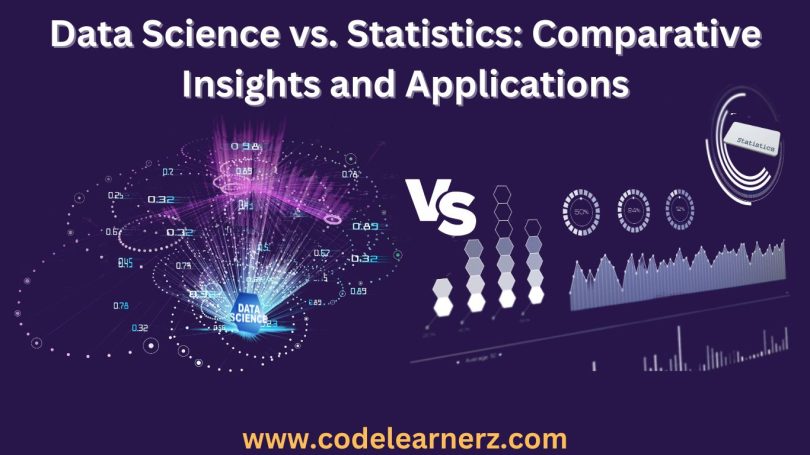In the contemporary landscape data science and statistics stand as pillars of progress, driving advancements and simplifying complexities in today’s world. Although distinct, these fields are often intertwined, necessitating a nuanced understanding to seize the right career opportunities in specific domains. This comprehensive comparison elucidates the differences and similarities between data science and statistics, guiding readers through their intricacies.
Overview of Data Science:
Data science entails the precise management of data, encompassing tasks such as cleansing, integration, visualization, and statistical analysis. Data scientists develop models to solve intricate problems, utilizing a multidisciplinary approach. Machine learning and computer statistics are harnessed to extract valuable insights, enabling data-driven decision-making.
Key Tools for Data Scientists:
Data scientists employ a diverse toolkit, including programming languages such as R and Python for data analysis, machine learning, and visualization. They work with relational database management systems like MySQL, leverage big data tools like Apache Hadoop and Apache Spark, perform data analysis using statistical software like SAS or SPSS and communicate findings using visualization tools like Tableau, Matplotlib, Seaborn and ggplot2. NumPy and Pandas are two examples of libraries used in data manipulation.
Overview of Statistics:
A vital part of data analysis is the study of equations and mathematical ideas, which is what statistics does. Statisticians adeptly work with diverse data sets, identifying patterns, similarities and differences. They excel in making predictions through meticulous interpretation of results.
Data Science vs. Statistics: Key Differences.
The interaction between data science and statistics becomes a driving force in the complex field of data analysis, with each discipline bringing unique knowledge to the table. This comparative study highlights their mutually beneficial interaction, which drives progress in knowledge extraction and clarifies their salient differences.
Focus and Perspective:
From data collection to model deployment, data science takes a broad approach, focusing on problem-solving and real-world applications throughout the whole data lifecycle. Statistics, on the other hand, emphasizes the depth of data analysis by exploring methodological and theoretical issues.
Tools and Techniques:
For efficient communication, data scientists use a broad range of tools, such as Python, R, machine learning methods and data visualization software. Statisticians focus on statistical analysis and inference, honing methods and theories, and rely on specialist software such as SAS and SPSS.
Goals and Contributions:
Data scientists drive innovation, optimizing processes and decision-making to solve specific business problems. Statisticians focus on developing novel statistical methods, expanding existing techniques and challenging boundaries; enriching the field with innovative frameworks.
Data science benefits from the robust foundation of statistics, ensuring methodological validity, while statistics finds renewed challenges and applications in the dynamic realm of data science, fostering the evolution of statistical techniques. Together, they propel the realm of data analysis and knowledge extraction into new frontiers.
Where Data Science Meets Statistics: Similarities.
Data Science and Statistics have considerable overlaps in the complex fields of data analysis, sharing common goals and methods. This comparative analysis highlights the similarities and differences between the two fields, illuminating the ideas and methods they employ in common.
Data Collection: Both Data Science and Statistics embark on similar journeys in data collection, accessing databases, conducting experiments and utilizing APIs. They employ techniques like data mining, recording and web scraping, ensuring data quality through validation and verification processes.
Data Pre-Processing: For both domains, it is critical to clean collected data. Maintaining consistency and integrity involves eliminating errors, disturbances and inconsistencies as well as dealing with anomalies and missing numbers.
Data Analysis: Both specialties carefully examine data in order to glean insights and make relevant judgments. They use a variety of techniques for making predictions and comprehending phenomena, including statistical notions and quantitative procedures.
Model Building: Data Science and Statistics share the endeavor of constructing and utilizing models for data analysis. From machine learning models to regression and time series models, they capture and represent dependencies within data.
Measure of Uncertainty: In order to account for the unknown and use methods to efficiently quantify and manage uncertainty, both domains recognize the intrinsic uncertainty in data.
Presentation of Results: The focus of data science and statistics is on succinct, unambiguous results presentation that can be understood by both expert and non-technical audiences. Their engrossing articulation of findings guarantees thorough comprehension.
In the choice between Data Science and Statistics, the decision hinges upon specific context, work requirements and objectives. Data Science excels in handling vast, complex datasets and predictive modeling for real-world applications, employing advanced computational techniques. Statistics, rooted in mathematics and statistical methods, shines in experimental design, hypothesis testing and understanding data relationships.
Choosing Between Data Science and Statistics: Key Considerations:
Scope of Analysis: Data Science suits extensive analysis of large datasets and employs advanced computational methods, while Statistics excels in experimental design, hypothesis testing and utilizing statistical methods to understand data relationships.
Industry Applications: Technology, healthcare and finance are just a few industries where data science is used in predictive modeling and machine learning. On the other hand, statistics flourishes in social sciences and academic research-focused fields.
Skill Set: Statisticians emphasize statistical theory, mathematical rigor, and experimental design, while data scientists specialize in big data technology, programming and machine learning.
Summary:
In a nutshell, data science and statistics are two vital pillars, each with unique strengths. This comparison highlights their differences and commonalities. Data science focuses on data handling, modeling and real-world applications. It utilizes tools like Python, R and big data technologies. Statistics, on the other hand, delves deep into mathematical concepts, patterns and predictions. Both fields emphasize data collection, analysis, model building and managing uncertainty. They adeptly communicate results for diverse audiences. The choice between them hinges on specific requirements. Data science excels in vast, complex datasets, while statistics thrives in experimental design. This comparison equips individuals and organizations to navigate the dynamic world of data analysis, where both data science and statistics play pivotal roles, offering transformative insights for the future.



